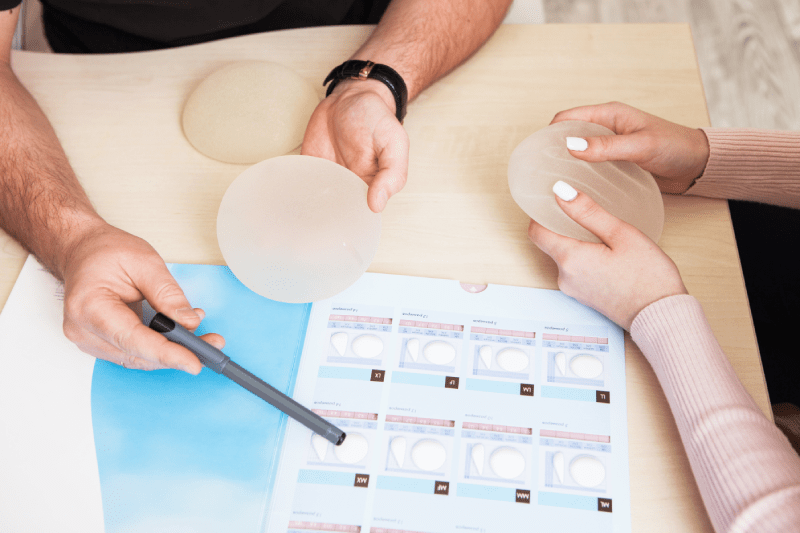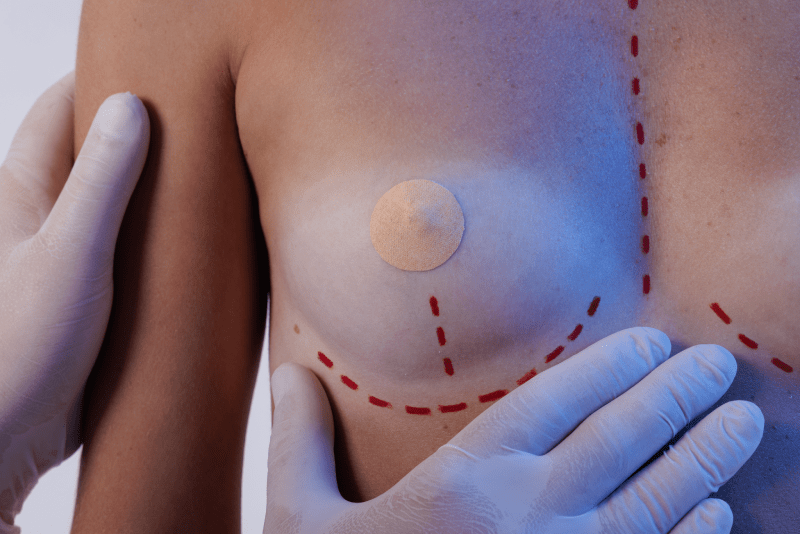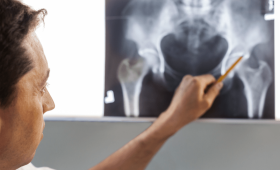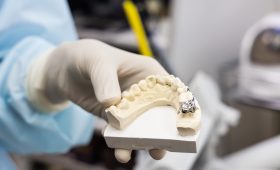What is Breast Asymmetry?
Breast asymmetry is a condition where one breast is different from the other in terms of size, shape, position, or volume. This means that the two breasts are not exactly the same, which is a natural characteristic of the human body. Asymmetry can be minimal and barely noticeable, while in some cases, it can be a more significant imbalance. Most people have small differences between the right and left sides of their body, and breast asymmetry is a natural reflection of this biological fact.
Why is One Breast Bigger Than the Other?
The main reason for the difference in breast size is that one breast grows faster or at a different rate than the other during the development process. This usually starts during puberty and is caused by the uneven distribution of breast tissue, fat, and glandular tissue (milk glands) in both breasts. Genetic factors also play a significant role in this asymmetry; if there are individuals in your family with breast asymmetry, it’s more likely to occur in you as well. Hormonal fluctuations are the biggest trigger for this process.
Is Breast Asymmetry Normal?
Absolutely yes. Breast asymmetry is a very common and completely normal condition for women of all ages. Medical experts state that “perfectly symmetrical” breasts are extremely rare. Just as your right hand is slightly different from your left hand, or one leg is different from the other, it is natural for breasts to have a slight difference. This difference is generally not a sign of a health problem and is not usually considered a cause for concern.
The 10 Most Common Causes of Breast Asymmetry
- Normal Development: Breasts can grow at different rates, especially during puberty. This is often a result of hormonal changes, and the asymmetry may correct itself once the growth process is complete.
- Genetic Factors: A family history of breast asymmetry increases the likelihood of this condition occurring in you.
- Hormonal Changes: Fluctuations in estrogen and progesterone levels during different stages of life, such as puberty, the menstrual cycle, pregnancy, and menopause, can affect breast tissue development differently.
- Breast’s Biological Structure: One breast may naturally have more glandular (milk gland) or fatty tissue than the other, causing a size difference. Glandular tissue density is a critical factor in determining breast size and shape.
- Breast Position and Posture: Certain posture issues, scoliosis (spinal curvature), or chest wall deformities can affect the position of the breasts on the chest, creating a visual imbalance.
- Breast Shape: In addition to a size difference, the shape of the breasts can also be different. One breast may be conical, while the other is more rounded, creating a visual asymmetry.
- Lumps or Masses: Benign growths such as cysts (fluid-filled sacs), fibroadenomas (benign solid masses), or lipomas (fatty lumps) can cause a change in breast size and shape. These masses are usually painless and are not cancerous.
- Fibrocystic Changes: Due to hormonal changes, especially before the menstrual cycle, breasts may become swollen, tender, and lumpy. This can cause the breasts to temporarily appear more asymmetrical.
- Congenital Conditions: In rare cases, congenital conditions such as Poland syndrome can cause a partial or complete absence of breast tissue or chest muscles (pectoralis major) on one side.
- Tumors: Although very rare, malignant (cancerous) tumors can cause rapid and noticeable changes in breast size, shape, or tissue.
What can you do about uneven breasts?
Having breasts that are not exactly the same size or shape is a very common condition among women. This asymmetry is generally harmless and is noticeable in most women. However, if this situation bothers you, there are steps you can take.
Tips to Manage Asymmetry
- Choosing the Right Bra: One of the most effective ways to conceal breast asymmetry is to use the right bra. Bras with padding or removable inserts, in particular, can help balance the two breasts by supporting the smaller one. When shopping for a bra, you can choose a model that fits the larger breast and use a pad to support the other. This will help you in terms of both comfort and aesthetics.
- Clothing Selection: V-necks, patterned tops, or ruched blouses can make asymmetry in the breast area less noticeable. Blouses or dresses with asymmetrical cuts also help draw attention to other points away from the breasts.
- Posture: An upright and correct posture makes your body lines look more proportional and naturally masks the asymmetry in your breasts. Keeping your shoulders back, straightening your back, and holding your head up will positively affect your overall appearance.
- Exercise: Some breast and back exercises (e.g., push-ups or weight lifting) can help strengthen your pectoral muscles, making your breasts look fuller and firmer. However, these exercises do not completely eliminate asymmetry. Working these muscle groups equally can increase overall balance.
When Should You See a Doctor?
In most cases, breast asymmetry is normal. However, it may be beneficial to consult a doctor in the following situations:
- If the asymmetry appeared suddenly or has increased significantly over time.
- If there are symptoms such as hardness, swelling, pain, or skin changes (redness, wrinkling) in the breasts.
- If you observe nipple discharge or a change in shape.
These symptoms may be a sign of an underlying health problem and may require a professional medical evaluation.
Breast Asymmetry During Puberty: When to Worry?
Puberty is the period when breasts grow fastest and asymmetry is most common. The asymmetry during this time usually corrects itself within a few years. However, the following situations can be cause for concern and require a consultation with a doctor:
- The size difference in the breasts is rapidly and continuously increasing.
- A new, hard, and non-mobile lump or mass forms in the breast that was not there before.
- Skin or color changes on the breast, such as redness, dimpling (orange peel appearance), or prominent veins.
- Abnormal discharge, such as bloody, yellow, or dark-colored fluid, coming from the nipple.
- Persistent warmth, swelling, or severe pain in the breast that may indicate inflammation.
If these symptoms are present, it is important to seek medical attention without delay as they may indicate an underlying health issue.
Hormonal Changes Causing Breast Asymmetry
The hormonal balance in the body has a direct impact on the health and size of breast tissue. Specifically, the hormones estrogen and progesterone are responsible for the development of breast glands and fatty tissue. During puberty, the secretion levels of these hormones can be irregular, which can cause one breast to receive more hormonal stimulation than the other, leading to asymmetrical growth. Similarly, hormonal fluctuations during the menstrual cycle can also cause temporary asymmetry.
Breast Asymmetry and Scoliosis
Breast asymmetry, a common concern for many women, has been found to be significantly more prevalent in individuals with scoliosis, a condition characterized by a sideways curvature of the spine. This report explores the documented relationship, the underlying anatomical causes, and the patterns of asymmetry observed in medical studies.
The Role of Spinal and Rib Cage Deformity
Scoliosis is not just a lateral curve of the spine; it is a complex, three-dimensional deformity that also involves rotation of the vertebrae. This rotation is most pronounced in the thoracic (mid-back) region, where the ribs are attached. As the spine curves and rotates, the ribs on the convex (outward-curving) side are pushed outward, creating a “rib hump,” while the ribs on the concave (inward-curving) side are compressed.
This distortion of the rib cage directly impacts the development and position of the breasts. The breast tissue on the convex side of the curve is often restricted by the protruding ribs, while the tissue on the concave side has more space to develop. This leads to a predictable pattern of asymmetry.

Documented Patterns of Asymmetry
Medical studies have consistently shown that women with idiopathic scoliosis frequently exhibit a specific pattern of breast asymmetry. The breast on the convex side of the thoracic curve is typically smaller in volume. It is also often positioned higher on the chest, with a shorter sternal-breast distance and a smaller areola.
Conversely, the breast on the concave side of the curve tends to be larger in volume and positioned lower. The differences are not just in size, but also in the overall shape and position on the chest wall, including the nipple and inframammary fold (the crease beneath the breast).
Correlation with Scoliosis Severity
While breast asymmetry is a consistent finding in scoliotic patients, the relationship between the degree of breast asymmetry and the severity of the scoliotic curve (measured by the Cobb angle) is not always straightforward. Some studies have found a significant correlation between breast volume difference and Cobb angle, while others have reported no such link. This suggests that while scoliosis is a primary cause of the asymmetry, the final appearance can be influenced by other individual factors.
In conclusion, breast asymmetry in women with scoliosis is a well-documented phenomenon caused by the anatomical changes in the rib cage. The asymmetry often follows a predictable pattern, with the breast on the convex side of the scoliotic curve being smaller and higher. Understanding this connection is important for both patients and healthcare providers, as it can help in managing both the physical and cosmetic concerns associated with the condition.
Breast Size Difference During Pregnancy and Breastfeeding
Pregnancy is a time when breasts grow in size and volume to prepare for milk production. During breastfeeding, if a baby nurses more frequently or for longer on one breast than the other, this breast may produce more milk and consequently appear larger. This condition usually resolves once breastfeeding ends and the breasts return to their previous size. However, some women may have a slight permanent asymmetry.
Breast Asymmetry as a Part of Natural Development
Breast asymmetry is a reflection of the fact that the human body is not perfectly symmetrical. Our eyes, nostrils, and even the two sides of our face are not exactly the same. This natural asymmetry does not hinder the ideal functioning of the body and usually does not mean there is a health problem. It is important to see this condition as a unique and natural part of your body.
Aesthetic and Surgical Solutions for Breast Imbalance
If breast asymmetry causes a loss of self-confidence, psychological distress, or difficulties in choosing clothes, various aesthetic and surgical solutions are available. Some of these procedures include:
- Breast Augmentation: Placing silicone or saline implants in the smaller breast to match the size and volume of the other breast.
- Breast Reduction: Removing excess tissue from the larger breast to bring it to a size that is appropriate for the other breast.
- Breast Lift (Mastopexy): Lifting and reshaping sagging breasts.
- Lipofilling (Fat Injection): Injecting fat taken from another area of the body into the smaller breast to give it volume.
For these options, it is always important to have a detailed consultation with a plastic surgeon and to be informed about the possible risks.
When to Consult a Specialist for Breast Asymmetry
Although breast asymmetry is usually harmless, some symptoms can be a sign of a serious health problem. You should definitely consult a doctor in the following situations:
- Sudden Onset of Asymmetry: A sudden or rapidly increasing size difference in a breast that was not previously asymmetrical.
- New Lump: A new, painful or painless, non-mobile lump felt in the breast.
- Skin Changes: The appearance of an orange peel texture, redness, dimpling, or prominent veins on the breast skin.
- Abnormal Discharge: Bloody, clear, or any colored discharge coming from the nipple.
- Severe Pain: Severe breast pain with no known cause that does not go away.
These symptoms may be a sign of an underlying health problem, and consulting a specialist for early diagnosis is of vital importance.
Everything You Need to Know About Breast Size Difference
- It’s Very Common: Most women experience slight or noticeable breast asymmetry at some point in their lives. This is part of the body’s normal development.
- It’s Generally Harmless: In most cases, asymmetry is an aesthetic condition and does not pose a health risk.
- It Can Be Concealed with Clothing: Padded bras, bra inserts, or clothing made of thick fabrics can easily help conceal asymmetry and provide comfort with clothing choices.
- The Effect of Hormonal Changes: A difference in breast size is quite normal during periods of hormonal changes such as puberty, pregnancy, and menopause.
- Professional Support: If asymmetry is causing you physical or psychological discomfort, you can consult a healthcare professional or an aesthetic surgeon to evaluate your options.
Misconceptions and Facts About Breast Asymmetry
- Misconception: Breast asymmetry is always a sign of a serious illness.
- Fact: Asymmetry is most often a physiological and normal condition. Serious illnesses usually show themselves with other symptoms accompanying the size difference.
- Misconception: Women with breast asymmetry are aesthetically flawed.
- Fact: No woman has perfectly symmetrical breasts. Slight asymmetry is universal and is a unique, natural part of every body.
- Misconception: Asymmetry must be corrected with surgery.
- Fact: Surgery is an option chosen only due to the individual’s discomfort with the asymmetry and is not mandatory.
Psychologically Coping with Breast Asymmetry
Breast asymmetry can have negative effects on body image and self-confidence. To cope with this situation, you can try the following ways:
- Self-Acceptance: Trying to accept this natural difference in your body is the first step to boosting your self-confidence. Every body is unique.
- Developing a Positive Body Image: Focus on loving your body as a whole and avoid over-focusing on your breasts.
- Support Groups: Talking to and getting support from others who have similar experiences can make you feel less alone.
- Professional Help: If your concerns about your body image are negatively affecting your life, talking to a therapist or counselor can help you manage this process.
- Gaining Knowledge: Knowing how common and normal breast asymmetry is can greatly reduce your concerns.

Serious Health Problems Caused by Breast Imbalance
In very rare cases, breast asymmetry can be a symptom of some serious health problems:
- Scoliosis: The curvature of the spine can cause one side of the ribcage to be higher or to protrude more than the other, creating an imbalance in the position and appearance of the breasts.
- Poland Syndrome: This rare congenital condition causes a partial or complete absence of breast tissue, the nipple, or the chest muscles (usually the pectoralis major) on one side.
- Breast Cancer: Although breast asymmetry alone is not a symptom of breast cancer, asymmetry accompanied by other symptoms such as a new lump in the breast, a rapid change in breast shape or size, skin dimpling, or puckering, requires medical evaluation. Regular breast exams and mammograms are very important for early diagnosis.
Deformities In The Chest Wall
Chest wall deformities are developmental disorders that occur in the breastbone (sternum) and ribs. These conditions are usually congenital and can become more prominent during adolescence. The two most common deformities are known as sunken chest (pectus excavatum) and protruding chest (pectus carinatum).
Pectus Excavatum (Sunken Chest)
Pectus excavatum is the most common chest wall deformity. It is characterized by the breastbone and ribs growing inward. The deformity can range from a slight indentation to a severe inward bend.
Symptoms:
- Physical Symptom: A prominent indentation in the center of the chest.
- Heart and Lung Symptoms: In severe cases, it can put pressure on the heart and lungs, leading to symptoms such as shortness of breath, chest pain, fatigue, and heart palpitations.
- Psychological Effects: Especially in adolescents, it can cause body image anxiety and self-esteem issues.
Treatment Options:
- Conservative Treatment: In mild cases, a device called a vacuum bell is used to pull the chest wall outward. This treatment is particularly effective in young patients.
- Surgical Treatment: Surgical intervention may be necessary for severe deformities. The most common surgical methods are:
- Nuss Procedure: Involves placing one or more metal bars inside the chest to push the breastbone upward.
- Ravitch Procedure: Involves removing the deformed cartilage and bone and reshaping the breastbone to a proper position.
Pectus Carinatum (Protruding Chest)
Pectus carinatum is a deformity that results from the breastbone and ribs growing outward. This condition causes the chest to appear like a pigeon chest.
Symptoms:
- Physical Symptom: A prominent or protruding appearance in the middle or on the sides of the chest.
- Respiratory Issues: In severe cases, shortness of breath and wheezing can be observed, especially during exertion.
- Psychological Effects: Similar to pectus excavatum, this deformity can cause body image anxiety.
Treatment Options:
- Conservative Treatment: In mild to moderate cases, a brace is used to apply external pressure to the breastbone, allowing it to gradually reshape over time.
- Surgical Treatment: Surgical intervention may be considered in cases where brace treatment fails or the deformity is very advanced. Surgical methods typically involve a modified Ravitch procedure.
Frequently Asked Questions about Deformities In The Chest Wall
Do chest wall deformities cause pain? They generally do not cause pain, but in severe cases or during sports activities, chest pain and a feeling of discomfort may occur.
What happens if deformities are not treated? Untreated deformities can lead to physical (impaired heart and lung function) and psychological problems. Therefore, monitoring and evaluation, especially during adolescence, is important.
Which doctor should I see? Thoracic surgery specialists have a key role in the diagnosis and treatment of these deformities.
Are deformities genetic? Yes, these conditions can often be seen in families, and there is a genetic predisposition.
Juvenile Hypertrophy And Breast Asymmetry
Juvenile hypertrophy (virginal breast hypertrophy) is a rare, benign condition characterized by abnormally rapid and excessive growth of breast tissue during adolescence. This condition typically emerges during puberty when breast development begins.
While it usually affects both breasts, it can also occur in a single breast. The growth rate can vary from person to person, starting abruptly and then continuing at a slower pace.
Symptoms and Effects
Juvenile hypertrophy can lead to both physical and psychological problems. The main symptoms and effects include:
- Physical Symptoms: Back, neck, and shoulder pain due to the weight of the breasts. Bra straps digging into the shoulders, skin irritation under the breasts (intertrigo), and poor posture.
- Psychological Effects: It can cause significant psychological issues for young individuals, such as social embarrassment, loss of self-confidence, and anxiety.
Causes and Treatment
The exact cause of juvenile hypertrophy is not fully understood. However, factors such as the breast tissue’s extreme sensitivity to normal levels of hormones (especially estrogen) or hormonal imbalances are believed to play a role.
Treatment options vary depending on the severity of the condition and the problems the patient is experiencing. Generally, the most effective and definitive solution is breast reduction surgery (reduction mammaplasty). This surgery helps relieve the patient’s physical discomfort and improves their psychological well-being. Although there is a possibility of recurrence (regrowth) after surgery, this is rare, and most patients achieve lasting relief from the operation.
What Is Breast Asymmetry Surgery?
Breast asymmetry is a very common condition in women, meaning that the breasts differ from each other in size, shape, or position. While often mild, this condition can cause aesthetic or psychological discomfort in some people. Breast asymmetry surgery is a surgical procedure performed to correct these differences and provide a more symmetrical appearance between the breasts.
Objectives of the Surgery
The primary goal of this surgical procedure is to bring both breasts to a size, shape, and position that are closer to each other. This can help the patient increase their self-confidence and feel more comfortable with their body image. The surgery can be performed on a single breast or may include corrections on both breasts.
Surgical Methods Used
Breast asymmetry surgery can be performed using different methods depending on the degree and type of asymmetry:
- Breast Augmentation: A breast prosthesis (silicone implant) is used to enlarge the smaller breast. This method is preferred when there is a significant difference in size between the two breasts.
- Breast Reduction: Breast tissue and excess skin are removed to reduce the larger breast and bring it to a size that is suitable for the other breast.
- Breast Lift (Mastopexy): Performed to lift and reposition the more sagging breast when the breasts are at different positions. This procedure can sometimes be combined with breast reduction or augmentation.
- Fat Injection (Fat Transfer): Involves injecting fat taken from another part of the body into the smaller breast to add volume. This method is generally preferred for cases of mild asymmetry.
Pre- and Post-Surgery Process
Before the surgery, it is important to have a detailed consultation with your surgeon to share your expectations and medical history. The recovery process after the surgery varies depending on the type of procedure performed. Normal activities can usually be resumed within a few weeks.
Risks and Considerations
As with any surgical procedure, breast asymmetry surgery carries risks such as infection, bleeding, scarring, or anesthesia-related complications. Therefore, it is very important to have an open discussion with your doctor about all risks and expectations before the surgery.
Remember, every patient and asymmetry condition is different. It is essential to consult with a plastic surgeon to determine the most suitable treatment plan.
Breast Asymmetry Treatment with Cure Holiday
Cure Holiday is the perfect address for breast asymmetry treatment. Our experienced and expert surgeons create personalized treatment plans to ensure you achieve the most natural and effective results.
We offer personalized consultations, accommodation, and transfers throughout your treatment, making it as comfortable and hassle-free as possible.
Contact us now for more information and a free consultation.



